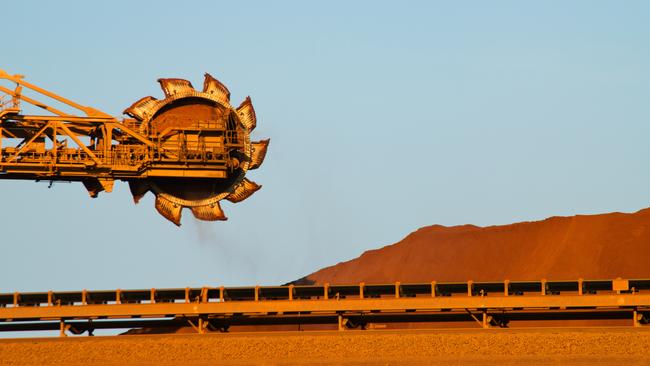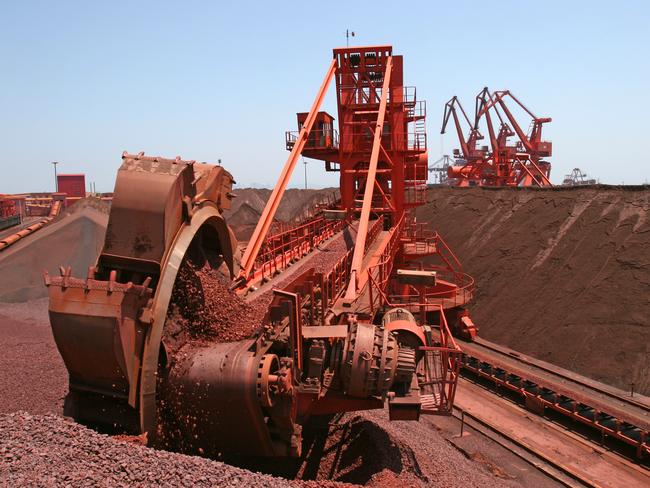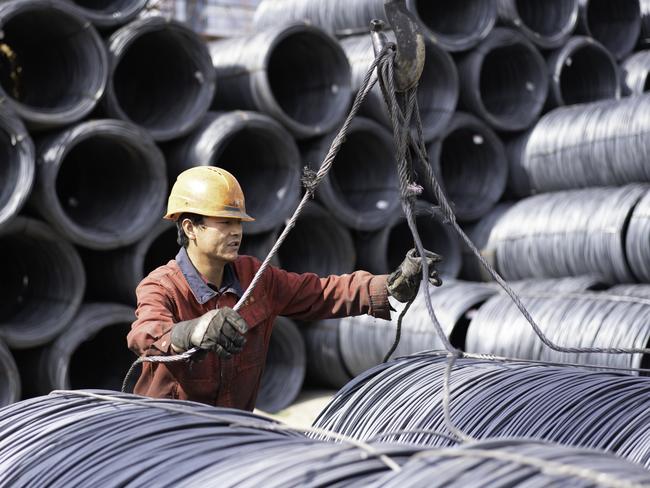Alarm bells for Australia as iron ore languishes at Chinese ports
Australia’s entire economy is heavily dependent on one thing – and signs at Chinese ports are not looking good.
Media
Don't miss out on the headlines from Media. Followed categories will be added to My News.
At the Australian Financial Review’s Banking Summit last week, shadow Treasurer Angus Taylor made the case that the Albanese Government had used the windfall from commodity exports as a substitute for budget management.
While one can make that argument, the simple reality is, in the years since China began its meteoric rise to become a global economic superpower, governments from the Coalition and the Labor Party have benefited enormously from the additional revenue the resources sector has provided relative to decades past.
From helping to fund the Howard Government’s introduction of the Family Tax Benefit to the electricity subsidies provided by the Albanese Government, commodity-driven government revenue has for better or worse become an increasingly instrumental input in the Treasury’s bottom line.
While it’s true that someone, somewhere will always need one commodity or another that will be produced in our vast Southern land, whether it’s coal for a power station today or lithium for grid-level energy storage tomorrow, this does not guarantee prosperity in the long term or the short, merely that the nation’s collective lot in life would be poorer without it.
In time, the rise in production of rare earth and other critical minerals key to the renewable energy future will take on a greater and greater share of total mineral exports. But for now, Australia has a heavy reliance on iron ore and coking coal exports, and by extension the demand for steel in China.

China’s vast steel production and consumption
According to data from the World Steel Association, China produced 1.02 billion metric tons of steel during the calendar year 2023, more than the rest of the world combined. China produced more than 7.25 times more steel than the second-place holder, India.
As of 2023, the biggest consumer of Chinese steel was the property sector, accounting for 33 per cent of the total, followed by infrastructure construction accounting for 25 per cent of the total. Despite Beijing’s attempts to diversify the Chinese economy away from infrastructure and property construction, the share of overall steel consumption flowing to these two vital industries has declined by just two per cent since 2020 (70 per cent vs. 68 per cent in the latest data).
A concerning sign
While Beijing has been talking up the shift toward a more consumer and hi-tech focused economy for a long time, there are some concerning signs for Australia that perhaps 2024 is the year when this course is pursued more seriously.

Currently, the inventories of iron ore sitting at China’s ports is surging strongly. Between the last week of December and the first week of March, the level of inventory is up by 18 per cent. In the last decade inventory levels have only risen to this degree during this time of the year once before in early 2014.
In that instance, it was the beginning of a multi-year drop in iron ore prices, which would eventually see prices drop by over 70 per cent, to the lowest levels since 2007.
There is a great deal of speculation by analysts more broadly that this may finally be the year when Beijing deploys a consumer and small business-focused stimulus program. If that is the case, the fundamentals for some of Australia’s key exports may deteriorate significantly.
However, it’s an open question as to whether or not that scenario comes to pass and even if it does, should it not prove as effective as expected, Beijing may turn to its old strategy of construction-driven stimulus.

Chinese economic strength = Australian economic strength?
For well over a decade there has been the perception that a strong Chinese economy would benefit Australia and this was generally the case for a long time. But as Beijing attempts to shift away from a construction-driven economic growth model and move toward a more consumer and hi-tech manufacturing-based economy, what benefits the Middle Kingdom no longer necessarily benefits Australia.
The Chinese economy may experience a boom at least for a time on a much heavier degree of support for households and small businesses, which is a strategy Beijing has so far been reticent to pursue on a truly grand scale.
But the effect on the Australian economy, if this hypothetical consumer-focused economic boom were to pass, may end up being negative in net terms. Despite potentially exporting more wine or shellfish into China, if this boom is driven by shifting stimulus funds away from the traditional infrastructure and property construction strategies, it could end up being a sizeable hit to the Australian economy in net terms.
To put the scale of the different exports into perspective, at its peak the Australian wine industry exported $1.2 billion worth of wine into China prior to the pandemic, a sizeable amount and certainly nothing to scoff at.
However, when compared with the nation’s iron ore exports to China alone, it amounts to approximately 4.2 days’ worth of exports for the nation’s most valuable commodity class.

While trade tensions between Beijing and Canberra have been reduced significantly over the almost two years since the Albanese government came to power, the various punitive trade actions taken by Beijing against Australian produce have not been entirely lifted.
Amid the continued rise in tensions between the West and China over all manner of issues from Chinese access to high-end computer chips to the ongoing disputes in the South China Sea, much of Australia’s exports to China remains vulnerable to punitive trade actions should Beijing choose to once more pursue that path.
Politics and commodities
While the Coalition may point out that the Albanese government is reliant on commodity export-driven revenue, it’s not altogether different to Labor pointing out that former prime minister Scott Morrison’s “Back In Black” campaign (the claim that the budget would be returned to surplus) was heavily built on additional commodity export revenue.
Ultimately, the reality is both sides of politics have built decades worth of budgets that benefited handsomely from the meteoric rise of commodity export-driven revenue. As long as the status quo continues this will likely continue well into the future.
But whether the lucky country will continue to hold remains to be seen.
Tarric Brooker is a freelance journalist and social commentator @AvidCommentator
Originally published as Alarm bells for Australia as iron ore languishes at Chinese ports





